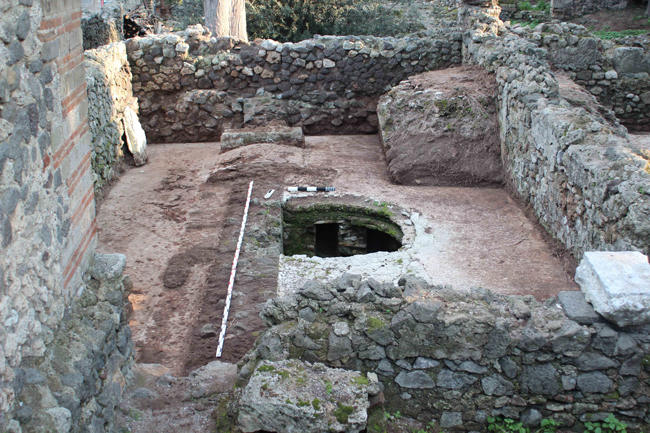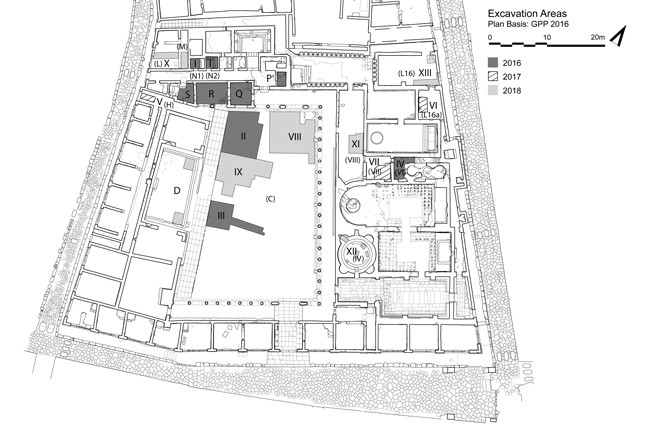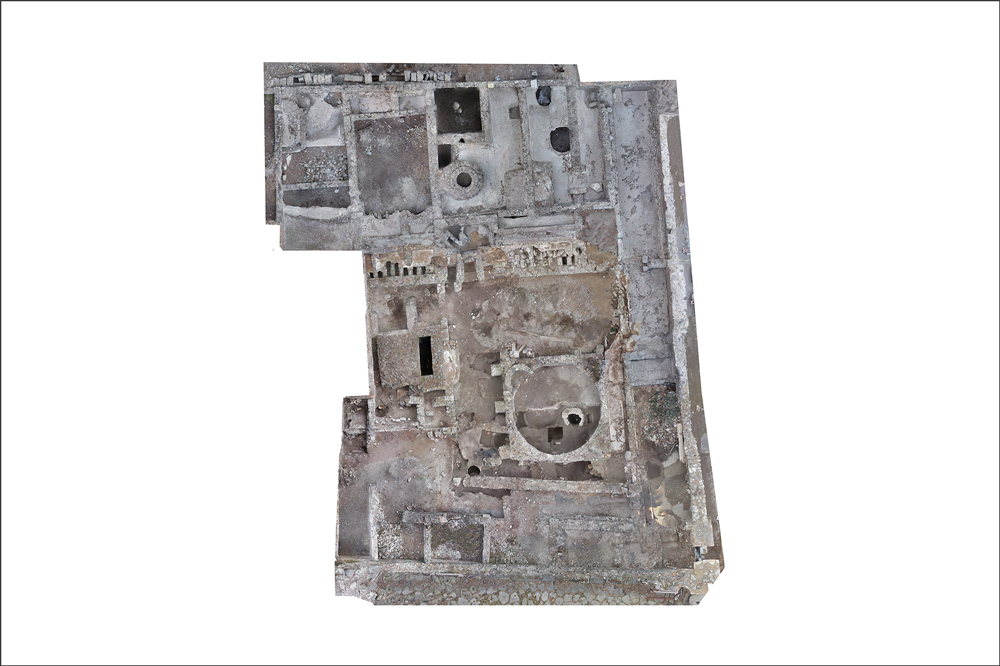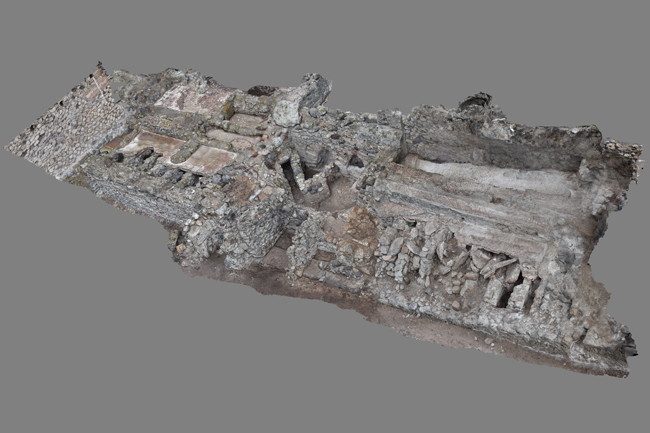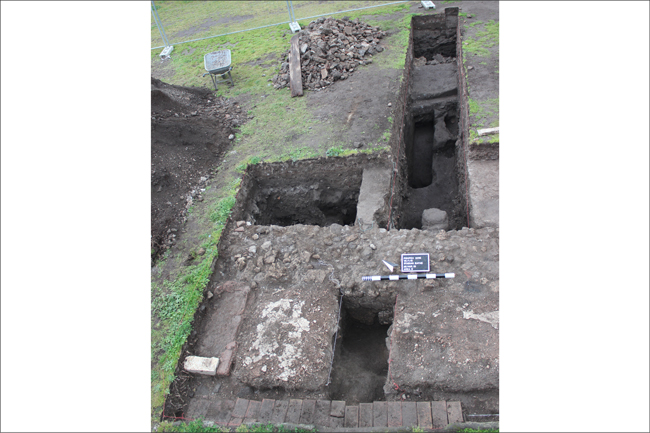In seven field seasons, carried out jointly with the University of Oxford, this research project investigated the development of two bathing complexes at Pompeii and their role in its urban development. The fieldwork results are contextualized within an overarching focus on the multifaceted phenomenon of cityscaping. This project contributes, beyond Pompeii and bathing culture, to current debates on the urbanization of Italy and the sociocultural, economic and political conditions, influences, and agents of this process.
Research
The development of a public collective bathing culture in Antiquity impacted directly on the formation of urban space and the socio-cultural function and perception of cities. The existence, location, accessibility, architectural context and infrastructure of public baths reflect changing standards and priorities of urban planning and lifestyle.
The first public baths (ca. 450 BC onwards) focused on individual bathing and cleansing aspects. In the Hellenistic period (3rd century BC onwards), there was a general trend towards more luxurious, innovative, collective, relaxing bathing forms. In the 2nd century BC, bathing programs were focused entirely on providing facilities for social and relaxing bathing. This final step required crucial innovations in technology and social concepts usually connected with Roman culture.
While the development of a specific Roman bathing culture in the Late Republican period currently is much debated, this topic is largely neglected in Pompeii, although the city includes three large baths dated to this period. This project analyzes two of these baths as key features of cityscaping. New excavations and detailed assessments of all standing remains, including the newest available 3D documentation and modelling techniques as well as traditional documentation methods, provide fresh insights into the history, development, function, and cultural and sociohistorical context of the two baths.
Results
The Stabian Baths are a key area for reconstructing the urban development of Pompeii and for studying the development of ancient bathing culture. According to Hans Eschebach (1979), the area was first occupied by an Archaic Altstadtmauer and from the 5th century BC onwards by a Greek palaestra with individual bathing cells that was gradually transforming, in six phases, into a Roman-type bath. Our excavations have shown that there is no trace of an early city wall at all, and that the Stabian Baths were only built in the late 2nd century BC and from the outset as Roman-type public bath. The complex was three times remodeled in line with new trends (after 80 BC, in the early 1st century AD, and between AD 41 and 79), and remained in use until the end of Pompeii in AD 79.
The Republican Baths received little attention after their excavation and preliminary publication in 1950, although the area is central for the urban development of Pompeii. This Topoi project achieved two major goals: for the first time, the Republican Baths, have been fully documented and analyzed using both traditional and state of the art digital approaches. Second, the barely examined and debated construction date and history of the complex as well as the functioning of its technology (water management, heating system) could be clarified. The Republican Baths developed as a private complex in the mid-2nd century BC and underwent several changes, which seem to have been mainly driven by practical necessities and less by new trends. While the Stabian Baths profited from the introduction of piped water into the city in the early Imperial period, the Republican Baths were abandoned around 30/20 BC and taken over by the owner of an adjacent house. The new owner used the terrain of the baths for a garden peristyle complex, which was once remodeled before it was significantly destroyed in the earthquake of AD 62. After this date, the terrain of the former baths was largely left in ruins and transformed into a building yard for quarrying volcanic ash and possibly for dumping building debris.
The project has shown that current understanding of the early phases of urban development in Pompeii must be revised, and has identified a direct link between urban development and the development of bathing culture: key points in the city’s development such as the transformation into a Roman colony in 80 BC and particularly the connection to the Serino aqueduct in the early Imperial period directly impacted on the baths studied – positively in the case of the Stabian Baths, negatively in the case of the Republican Baths.
The project has yielded and organized three international conferences: Development of Gymnasia and Graeco-Roman Cityscapes; Cityscaping and Bathing Culture in Ancient Italy and Cityscapes of Hellenistic Sicily: A Reassessment. Furthermore, the project received considerable interest in the media in Italy and Germany. It includes international staff from Germany, England, and Italy and from different disciplines (Classical Archaeology, Environmental Archaeology, History of Architecture, Numismatics, Hydraulic Engineering, and Geo Sciences) and has trained numerous students from universities in different countries, resulting in several BA and Master theses.
Excavation
Fieldwork with students from the Humboldt-Universität zu Berlin, Freie Universität Berlin, and the universities of Bamberg, Darmstadt, Freiburg, Oxford, and Toronto.
Project Partners
- Parco Archeologico di Pompei – Direttore Massimo Osanna
- University of Oxford, Dept. of Archaeology – Mark Robinson
- Albert-Ludwigs-Universität Freiburg, Institut für Klassische Archäologie – Jens-Arne Dickmann
- Technische Universität Darmstadt, Fachgebiet Klassische Archäologie/Bauforschung – Clemens Brünenberg
- Sapienza Università di Roma, Dipartimento di Scienze dell’Antichità – Antonio Ferrandes, Alessandra Pegurri
- Universität Mainz, Institut für Geowissenschaften – Cees Passchier, Gül Sürmelihindi
- Fachhochschule Lübeck, Fachbereich Bauwesen – Martin Strauß, Kai Wellbrock
- Brandenburg Technische Universität Cottbus-Senftenberg, Lehrstuhl Architektur und Visualisierung – Dominik Lengyel, Catherine Toulouse
- Scuola Normale di Pisa, Archeologia Classica – Gianfranco Adornato
- German Archaeological Institute Istanbul – Ulrich Mania
Related Links
For preliminary reports:

